Do Axolotls Make Good Pets? Care, Habitat & Food Guide
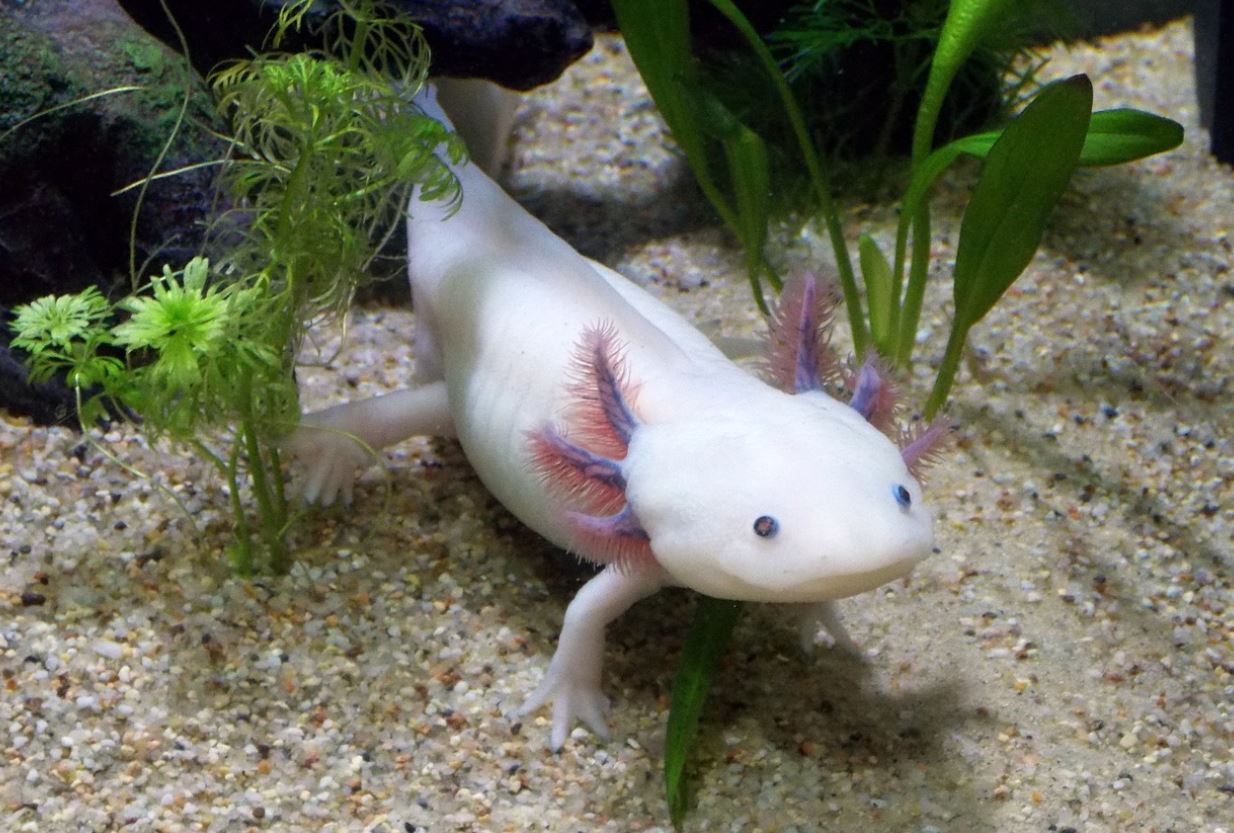
Axolotls are cute amphibians and are instantly recognisable by their adorable “smiles”. Their unique features have made them an important organism in various aspects of scientific research, and their distinctive appearance has turned them into a highly desirable exotic pet.
Axolotls are resilient animals that are relatively easy to care for with the correct resources. They can make excellent aquatic pets. However, they are not for everyone, and it is crucial that you arm yourself with knowledge of the species, as well as their care and maintenance, before deciding to house your own.
This article is a beginner’s guide to axolotls and their care, including their unique features, housing, feeding and diseases to watch out for.
What are axolotls?
Axolotls (scientific name Ambystoma mexicanum) are a species of salamander, also commonly referred to as the Mexican walking fish. However, these animals are not fish, they are a class of aquatic amphibians, breathing through their gills as well as pores on their skin. They are native to Lake Xochimilco in Mexico, where they were initially discovered in the 19th century.
What do axolotls look like?
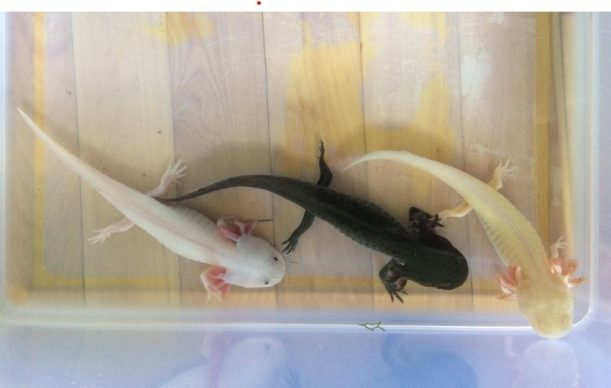
A sexually mature axolotl (roughly 12 months and over) averages at around 23cm in length, and anything over 30cm is unusual. They have flat, wide heads, and teeth which are barely visible, giving them their characteristic smile. These features are accompanied with wide-set black eyes, giving them the appearance of being very friendly.
Axolotls possess external gills, which are feathery during adolescence, and a dorsal fin. They also have short, delicate limbs. Axolotls can be many different colours. This includes “wild” which is characterised by tones of brown, black and green giving an olive colour overall, white, pink, and golden. These colours are entirely based on skin pigments and are a purely aesthetic feature.
Axolotls are highly unusual creatures
Axolotls don’t just look unique; they also possess several characteristics that are unusual in nature. They have various features that differ greatly from other amphibians and even other species of salamander.
Axolotls are neotenic
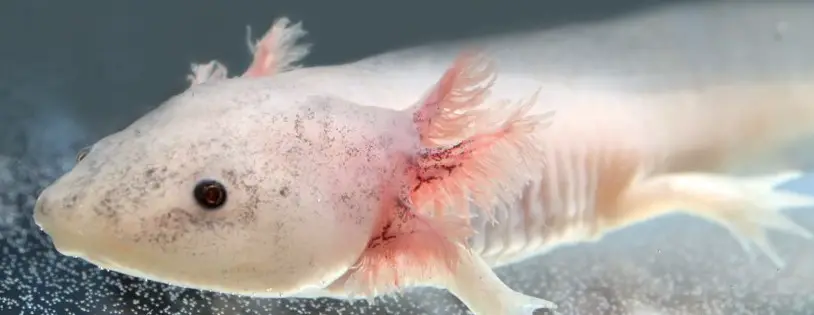
One of the most unique features of axolotls that makes them distinct from many other amphibians is a phenomenon called neoteny. Neotenic animals retain juvenile features, which disappear in similar animals, upon the animal reaching sexual maturity. A Nature news feature described them as “the creature that never grew up”.
Generally, amphibians (including other salamanders) undergo a process called metamorphosis, in which they transition from aquatic to terrestrial creatures. This means they spend the first part of their life in the water, and their adulthood on land. This process is accompanied by lots of physical changes to the morphology of the animal. In contrast, axolotls keep their dorsal fins and feathery gills, staying in water for their entire lives.
They are capable of limb regeneration
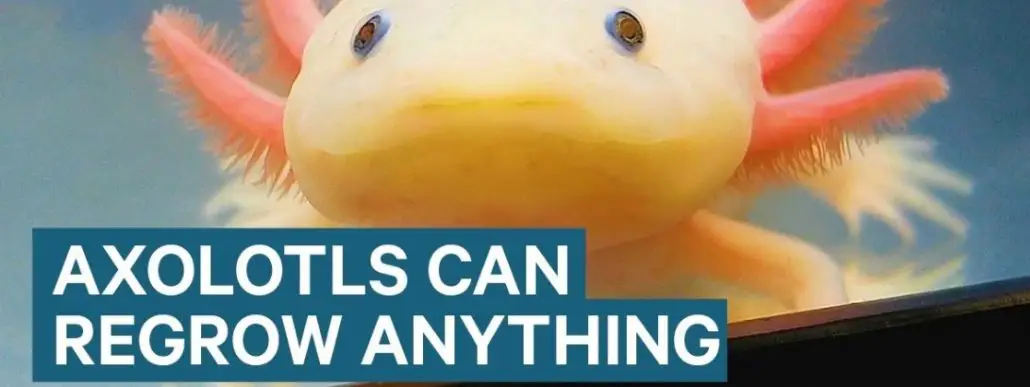
Another feature of the axolotl is the ability to regenerate some body parts as needed throughout their life, making them hugely important in scientific research into regenerative medicine, tissue engineering, and cancer.
Their regenerative features are not limited to the limbs, and is extended to their tails, other organs, parts of the eye and even parts of the brain. This is facilitated by their highly efficient and unique wound healing properties.
Their genome is huge
Axolotls have a genome among the largest ever sequenced by scientists. Whereas the human genome is comprised of 3 billion bases (the code that makes up genes), the axolotl genome consists of around 32 billion bases, making it over ten times larger. Their genome is so large and complex that it was only recently put together in its entirety and annotated by scientists, and it was published in the journal Nature in 2018.
Unfortunately, axolotls are rare in the wild
Axolotls are common in captivity due to their popularity as pets as well as their frequent use in scientific research, but their numbers are quickly decreasing in the wild. In fact, the National Geographic lists them as a critically endangered species. This is largely due to destruction of their natural habitat, pollution and invasive predators.
Are axolotls legal to own as pets?
The legality of owning an axolotl as a pet is dependent on your location. Axolotls are legal in most places, but in the U.S. some states have restrictions. For example, it is not legal to own an axolotl in California, and tight restrictions for sale, import and ownership exist in Maine, Virginia, California and New Jersey. In the rest of the USA it should be fine.
I’m convinced they are the pet for me – where can I buy one?
It is important that you buy pets from reputable sources. This is especially true for exotic pets, such as axolotls. Axolotls are often not available at traditional pet or reptile stores, as their housing requirements are slightly different from other reptiles and aquatic animals. Therefore, you might have to go to a reputable private dealer. If you are unsure, speak to a veterinarian with experience in exotic and aquatic animal care to find a good source.
Feeding your axolotl
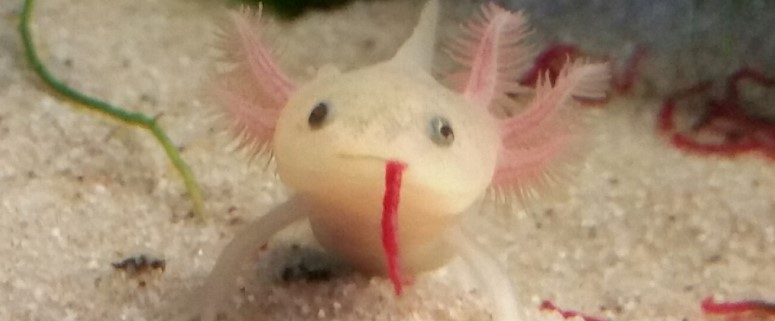
Axolotls are carnivores. They can eat a wide variety of live small aquatic organisms, such as tadpoles, small crustaceans, and various types of worms. This food can be live, dead/frozen or in the form of food pellets. Check out our article on how often Axolotls should eat here:
Live food
Normally, young axolotls are fed live food, and as they age can be moved on to pellets. Popular live food choices include worms such as nightcrawlers, bloodworms, and earthworms for larger axolotls. Be sure to get any live food from a trustworthy source to avoid disease.
Dead/frozen food
You can also feed your axolotl frozen or dead food. A popular food source for axolotls are frozen bloodworm cubes. These are highly nutritious and can be bought from local pet stores. You can even treat your axolotl by giving them cooked shrimp meat, providing they are in pieces small enough for your axolotl to handle.
Food pellets
One of the benefits of using soft food pellets is that live food might try to bite your axolotl, leading to potential skin lesions and leaving them more vulnerable to infection. Food pellets are also readily available, and, providing you choose a reputable brand, should contain all the nutrients required for your axolotl. Look out for pellets which are rich in protein and low in fat.
What foods should I avoid?
It might be a good idea to avoid live feeder fish to limit the chance of contamination in the tank, as these fish can be a source of parasites. You should also avoid any creatures with a hard, outer shell, including mealworms. These are difficult for axolotl to bite through, and even more difficult for them to digest.
Don’t overfeed your axolotl
An important feature of the axolotl is that it can be easily overfed. Axolotls should only need to be fed 3-4 times a week, and certainly no more than once per day. Some other sources say you should feed your axolotl little and often. This is because axolotls tend to gorge if given a large amount of food at one meal and could encounter digestive problems as a result. It is important that you remove uneaten food shortly after feeding to eliminate this, and to help with the maintenance of good tank hygiene.
You can watch the reactions of your axolotl at feeding time to assess how hungry they are and whether they require adjustments to their feeding schedules or amounts.
Preparing a home for your axolotl
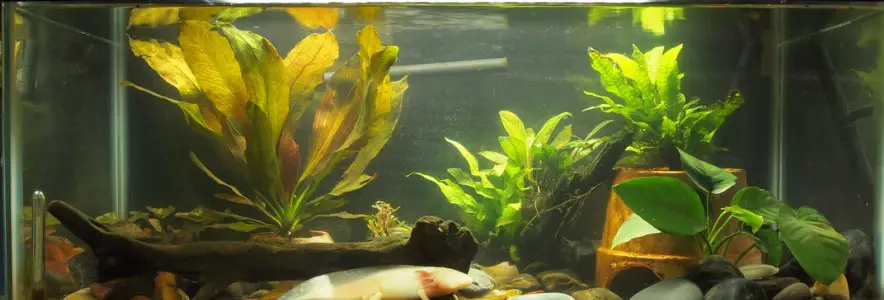
Axolotls are entirely aquatic and should be kept in a tank at all times. Regular maintenance of your tank is important
What size of tank do I need?
A single axolotl should not be housed in an aquarium any less than 10 US gallons (38 litres). Even still, a 20 US gallon tank is a safer option (76 litres). The more space the better! For each additional axolotl, your tank should be 10 US gallons larger.
Test your water quality
According to the axolotl health guide provided by Australian company Aquarium Industries, over 90% of ill health in aquatic pets is a result of poor water quality. Various features of water quality are important for axolotl health, including water temperature, pH, lighting and water hardness.
Temperature
Keeping a constant temperature in your tank is crucial to the health of you’re axolotl. Axolotls are kept in relatively cold conditions. Reptile magazine suggests that your tank should be kept at a temperature of 15-23°C, and never exceed 24°C. Temperatures higher than this will lead to your axolotl overheating, causing heat stress and loss of appetite. High temperatures can also potentially contribute to infection, and result in fatality.
If your living situation or location means you will struggle to maintain this temperature, you might have to rethink keeping an axolotl as a pet.
pH
Water of pH between 7.4 and 7.6 is ideal for axolotls. If the environment is too acidic, axolotls will display clinical signs including loss of appetite, floating and excess mucus production. Not keeping the tank clean enough can be a common cause of low pH.
Low Light Amphibians
When setting up your tank, ensure it is kept away from any uncovered windows or other light sources. Aside from the potential for light sources to heat up the tank, axolotls are nocturnal and light sensitive. Therefore, the tank should be kept somewhere where the lighting is consistently low and is limited throughout the day.
Be careful with gravel and other aquarium features
An important piece of advice from PetMD is to be careful with the gravel you select for the bottom of your tank. They warn that axolotls are highly curious animals and will try to consume any small items that resemble food, such as gravel or pebbles 3 cm or smaller.
Such ingestions can result in bowel obstructions, a common health concern in axolotls and can require surgery. Therefore, it is advisable to use large rocks (bigger than the salamander’s head) in place of gravel in your aquarium. Fine sand can also be used to line your tank, as this can pass through the gastrointestinal tract without obstruction. It is important that you do not leave the tank bare, as axolotl will struggle to grip the glass, potentially causing stress.
Ornaments such as plants and other decorative features can also be added to the tank environment. However, care should be taken to ensure that these fixtures lack sharp corners or rough exteriors; axolotls have delicate skin that is prone to tearing, opening the potential for bacterial infections in the skin.
Axolotls like to hide

Large rocks can also provide hiding places for axolotls, which is important to keep them happy. They are nocturnal and sensitive to light, and like having places to hide away during the day. Having multiple hiding places made up of rocks and shelters is a good idea, especially if you are housing more than one axolotl in one tank.
Filtration and tank maintenance
Axolotls produce a lot of waste, and therefore, maintaining tank hygiene is hugely important. If you choose to do this with the aid of a filter, fit your tank with a filter that provides the slowest water current possible. Too much water flow can cause stress to axolotls.
Filtration is not essential for axolotls. In fact, the experts at https://www.buy-axolotls.com state that if you do a 90% water change each week, you avoid the need for a filter.
Diseases in axolotl
If you are thinking about buying an axolotl, it is essential that you know the potential diseases that they can develop to, as well as the signs and symptoms.
Dr Richard Loh (also known as The Fish Vet) highlights that one of the major causes of disease in pet axolotls is because owners are not educated in their proper care. Therefore, being well-informed of the needs of your axolotl is crucial in giving it a healthy environment.
A recent Japanese study published in the Journal of Veterinary Medical Science found that some of the most common reasons for axolotls requiring vet care were hydrocoelom, buoyancy disorders, and bacterial skin disease. Other observed diseases included other skin conditions, foreign bodies in the gastrointestinal tract, bladder prolapse, and localised edema.
Hydrocoelom
Hydrocoelom described a situation in which the coelomic cavity is filled with fluid. The causes of this disease are unknown, but increased water temperatures are thought to be a risk factor. Hydrocoelom is common in amphibians and is largely thought to be a symptom of systemic poor health, rather than a disease of its own.
Buoyancy disorders
Buoyancy disorders are caused by incorrect distribution of gas within the body. One study suggests that lung lesions are a potential important cause, with air leaking into the body cavity from the lungs.
Skin conditions
Skin conditions are common in axolotl. They have delicate skin and should always be handled with a soft net to avoid any harm. Skin conditions are often caused by trauma, and then develop secondary infections such as fungal or bacterial invasions.
How will I know if my axolotl is sick?
There are multiple signs of stress and disease that you should be aware of and look out for in our axolotl. These include being poorly responsive to stimuli, degeneration of the gills, loss of appetite, curling of the tail tip, pale gill filaments, floating, and skin lesions.
How to keep my axolotl in good health?
To reduce the chance of your pet axolotl developing illnesses, they must be housed in an optimal environment. Any kind of stress as a result of their habitat has the potential to lead to generally poor health and propensity to develop disease.
One of the leading causes of axolotl ill health is their aquatic environment. Problems can include water of the wrong temperature, incorrect pH, water that is too fast flowing, and inefficient filtration or poor tank hygiene. Such problems create a toxic environment for your axolotl, and at worst could prove fatal.
If you are concerned about loss of appetite, Dr Loh has an informative video showing how this can be treated, including identifying the root cause, at home changes you can make, and medical interventions.
Other points to consider
Can axolotls be housed together?
Adult axolotls can be kept together. However, young axolotls should not be housed together, as they tend to bite one another, leading to tears in the skin, and causing infections. You may also have problems housing axolotls which differ in size by more than one inch, even if they are both in adulthood.
You might be able to house junior axolotls together if you provide them with plenty of space and a great diet, reducing stress. In fact, being generous with tank size is generally good practice for axolotl care. Axolotls should never be kept with other aquatic organisms such as fish.
Can I take my axolotl out of the tank?
No! Axolotls should not be handled unless absolutely necessary and should not be kept out of water for any length of time. All handing should be done with a soft mesh net, as they are very delicate.
For this reason, they should be considered more of a display animal, since pet/owner interaction is rare.
How long will my axolotl live for?
With proper care, nutritious diet, and optimal environment, axolotls can live 10-15 years, even up to 20 years. Therefore, purchasing one to keep as a pet is a long-term commitment, and not a decision that should be made lightly.
Conclusion
Axolotls can be a unique and special pet to welcome into your home. If you are willing to tightly control your aquatic environment and maintain optimum conditions, you could have a long-term friend in an axolotl pet! Once you have the environment set up and they are happy, they are very low-maintenance animals.
However, the axolotl is not for everyone. If you are looking for a companion you can cuddle and interact with or are unwilling to be vigilant when it comes to tank care and water-changes, you might wish to you may wish to look elsewhere.
Importantly, PetMD suggests that axolotls are not a good starter pet. You might want to begin with a simple fresh-water aquarium set up and get some care and maintenance experience before deciding to house an axolotl, which perhaps require more specialist care.


